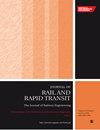Dynamic behaviour of bridges under critical conventional and regular trains: Review of some regulations included in EN 1991-2
IF 2.1
4区 工程技术
Q3 ENGINEERING, CIVIL
Proceedings of the Institution of Mechanical Engineers Part F-Journal of Rail and Rapid Transit
Pub Date : 2024-04-29
DOI:10.1177/09544097241245150
引用次数: 0
Abstract
In the field of structural analysis dedicated to the study of vibrations of high-speed railway bridges, one reference load model is the well-known HSLM-A, which limits of validity are stated in Eurocode EN 1991-2, Annex E. In a recent paper published in the Journal of Rail and Rapid Transit, the authors investigated the degree of coverage provided by HSLM-A to critical articulated trains. Now in the present article, the authors have extended those analyses to critical conventional and regular trains as well. This is an important aspect because HSLM-A as such is an articulated-type model, so it is of interest to understand how it deals with covering the various resonance phenomena generated by other train types. Therefore, the main goal of this work is to establish whether the conventional and regular trains that stem from the validity rules given in Annex E/EN 1991-2, produce vibratory effects that are duly covered by HSLM-A. Following the aforementioned validity rules, one first aspect analysed is the importance of near-to-integer wheelbase ratios in the coupled vibrations produced by conventional trains. Subsequently, seven realistic, conventional and regular high-speed train models have been synthesised; these models have been made publicly available in Mendeley Data, and comprise almost 3800 different sequences of axle loads. Finally, the response of simply-supported bridges has been analysed with a view to compare the seven synthesised models versus HSLM-A. The exceedance and required speed increase have been computed for both displacements and accelerations, in a comprehensive ensemble of spans and speeds. The results provide a diagnosis of the degree of coverage of HSLM-A with respect to those conventional and regular trains compliant with Annex E/EN 1991-2.常规列车和普通列车对桥梁的动态影响:对 EN 1991-2 中某些规定的审查
在专门研究高速铁路桥梁振动的结构分析领域,一个参考荷载模型是众所周知的 HSLM-A,其有效性限制已在欧洲规范 EN 1991-2 附件 E 中说明。在最近发表于《铁路与捷运期刊》的一篇论文中,作者研究了 HSLM-A 对临界铰接列车的覆盖程度。现在,在本文中,作者将这些分析也扩展到了临界常规列车和普通列车。这是一个重要方面,因为 HSLM-A 本身就是一个铰接式模型,因此了解它如何处理其他类型列车产生的各种共振现象是很有意义的。因此,这项工作的主要目标是确定,根据附件 E/EN 1991-2 中给出的有效性规则,常规列车和普通列车产生的振动效应是否被 HSLM-A 所适当涵盖。根据上述有效性规则,首先分析的一个方面是轮距比接近整数对常规列车产生的耦合振动的重要性。随后,我们合成了 7 个真实的常规高速列车模型;这些模型已在 Mendeley 数据库中公开发布,包括近 3800 种不同的车轴载荷序列。最后,对简单支撑桥梁的响应进行了分析,以便将七个合成模型与 HSLM-A 进行比较。在跨度和速度的综合组合中,计算了位移和加速度的超限和所需的速度增加。结果对 HSLM-A 与符合附件 E/EN 1991-2 的常规和普通列车的覆盖程度进行了诊断。
本文章由计算机程序翻译,如有差异,请以英文原文为准。
求助全文
约1分钟内获得全文
求助全文
来源期刊

CiteScore
4.80
自引率
10.00%
发文量
91
审稿时长
7 months
期刊介绍:
The Journal of Rail and Rapid Transit is devoted to engineering in its widest interpretation applicable to rail and rapid transit. The Journal aims to promote sharing of technical knowledge, ideas and experience between engineers and researchers working in the railway field.
 求助内容:
求助内容: 应助结果提醒方式:
应助结果提醒方式:


